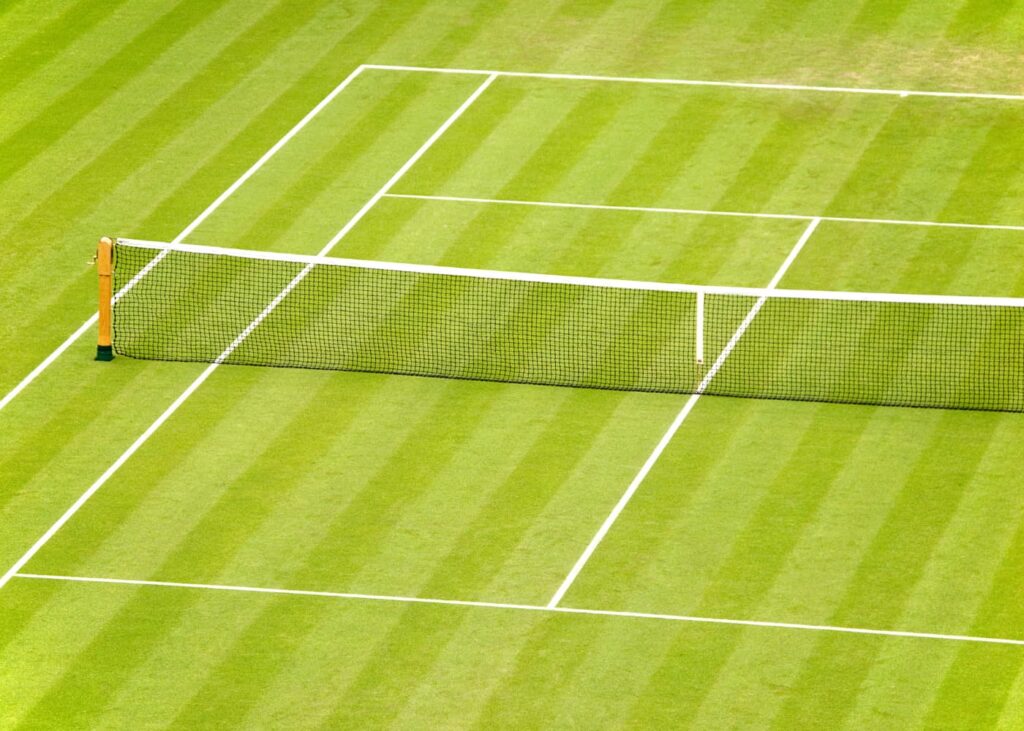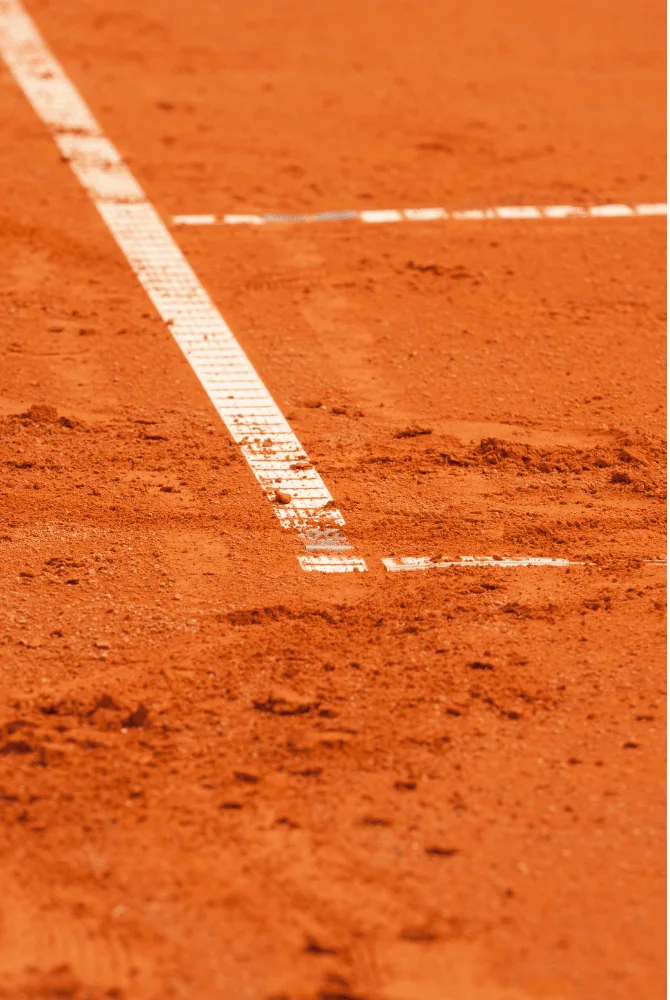Whether you’re just starting out playing tennis or have been playing for a while, it’s important to know about the different types of tennis courts. Different court surfaces can have a big impact on your tennis match.
At North State Resurfacing, we like all of our customers to be knowledgeable when it comes to the types of tennis courts so that they can have the best game possible. Our tennis court installation experts take a look at four of the most popular surfaces you’ll find in the game and their characteristics.

Hard Courts: The Versatile Surface
Hard courts are the most popular courts in the United States. They are found at parks, recreation centers, clubs, and schools. They are also referred to as acrylic or polyurethane court surfaces.
Characteristics of Hard Courts
Hard tennis courts are made from mixtures of asphalt and concrete as well as an acrylic surface layer to seal the surface. This also provides a level of cushioning. Hard surface courts have lower energy absorption, making the tennis ball bounce higher and move faster. This allows for long rallies. Hard courts are good for big servers because it can be easy to hit a lot of aces.
The Popularity of Hard Courts in Professional Tournaments
Hard courts are so popular that the majority of the largest professional tournaments are played on them. These include:
- Australian Open
- US Open
- ATP Finals
- 6 ATP 1000s
Maintenance Requirements and Challenges Associated with Hard Courts
Some of the challenges when playing on a hard court are that they generally become faster when exposed to sun and heat. So, you may have a different experience playing on the same court at different times of the day.
Hard tennis courts typically require little maintenance, another reason why they are so popular. But they still need to be free of debris. Leaving limbs or leaves on the surface can stain or discolor them.
You also want to make sure that no irrigation sprinklers are spraying on the court. This will cause water marks on the surface. Be sure that any spills on the court are also cleaned right away.

Grass Courts: A Tradition of Elegance
While grass tennis courts are considered the most elegant of surfaces, they can be hard to find these days. Their popularity rose between 1905 and 1974 when several Grand Slams were played on these types of fields. Right now, Wimbledon is the only Grand Slam played on a grass tennis court.
Unique Features of Grass Courts
A grass tennis court is made of a thick layer of clay, silt, sand, and a wearing surface of natural grass. Games can be different on grass courts because there many factors affect the game.
Things like how often the court is mowed, to how many players have been on it, and the overall quality of the grass, can make playing on this surface a challenge.
Advantages of Grass Courts
Grass tennis courts are the fastest type of court. They allow for lowball bounces and shorter rallies. The fast surface gives players with big serves an advantage because the ball is harder to return to start the point.
With grass courts, shots with slice are usually more effective than shots with topspin. Players with flat shots and those who are good volleyers tend to have the most success on grass courts.
While grass courts have many advantages, it can be difficult to break serves which is why some of the longest tennis matches in history were played on grass courts.
The Challenges of Maintaining Grass Courts
One of the reasons why grass courts are no longer that popular is that they require a good deal of maintenance. Besides cutting the grass, they can’t be played on if there is little rain.
To keep grass tennis courts in the best shape possible, they need to be watered after every use. A ballast roller also needs to be used at least once a week to compact the surface. They also need a drainage pipe in the foundation layer to avoid water from accumulating.
Artificial Grass Court Surfaces: A Modern Alternative
Artificial grass courts are built similarly to clay courts. After a regulating base layer is put on, a special turf is placed on top. It looks like a grass court but is easier to maintain. Some facilities opt for artificial grass court surfaces because of their softness and feel. The materials used are also non-toxic and don’t attract pests.
Benefits of Artificial Grass Courts
These courts usually have plastic grass fibers with better durability. The sand-filled topping that layers the surface of a synthetic turf court can protect the court from the elements. It also allows it to dry faster and makes it less susceptible to wear and tear.
When players are on this court, they’ll notice that the surface plays similarly to grass courts. The ball stays close to the ground but is not as slippery as traditional grass courts. This allows for more traction.

Clay Courts: The Classic Choice
Clay courts are very popular in Europe and South America. They are considered to be significantly slower than hard courts.
Characteristics of Clay Courts
Clay courts are made of a top layer of fine crushed aggregate. This can be stone, brick, shale, or other material. Below this top layer is usually another thicker layer that is made from the same material but in a compacted form.
There are two different forms of clay courts: red clay and green clay. Green clay courts are faster and more popular in the United States. Red clay courts are made from a course brick mixture. They are slower and more popular in South America and Europe.
The French Open is the only Grand Slam that uses a clay court. Professional tennis players Roger Federer and Rafael Nadal are considered to be two of the best clay-court tennis players currently.
Advantages of Clay Courts
Because of their textured surfaces, they provide the slowest surface for ball speed. This makes points last longer and is beneficial for baseline players who tend to be more defensive in their play.
Clay courts are also easier on the body because the surface is more shock-absorbent. They also allow players to slide rather than stop. This can help players to conserve their energy and play longer.
The construction of clay courts makes them slow and bouncy, which makes them great for strong baseliners and players who use a lot of topspin in their shots.
Maintenance Requirements and Challenges Associated with Clay Courts
Clay courts require frequent routine maintenance such as irrigation, rolling, and brushing. No matter how good you are at keeping up with maintenance, you can have a lot of bad bounces. If the court is not well-kept, the surface can become a bit uneven, and some bounces will not be playable.
Other Types of Tennis Courts
Other types of tennis courts are not as popular, such as carpet courts. Carpet courts are may by first putting down asphalt layers and then laying a special carpet or mat on top of it. Carpet courts are known to be very fast, favoring big serves and hitters.
Some other types of courts include tile, wood, and canvas. These are usually much faster and can be difficult to play on. They are extremely rare as well.
For Questions Regarding Your Tennis Court Surfaces, Contact the Professionals at North State Resurfacing
If you have questions about your tennis court surfaces, call the pros at North State Resurfacing. We can answer your questions and take care of any resurfacing projects you may have. Call us today at (919) 365-7500 to learn more.
